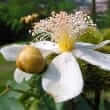Background
- Annatto is a pigment, or dye, produced from the red seeds of the achiote (Bixa orellana) tree. Achiote is native to the tropics of North and South America, the Caribbean, and the East Indies. It is cultivated in South America and Southeast Asia. Annatto has long been a staple of Latin American and Caribbean cuisines as a flavoring and coloring agent. Annatto adds a slightly sweet and peppery taste and yellow or red color.
- Achiote is known as the "lipstick tree" because the seeds have been used by Central and South American natives to make lip color, as well as body paint and fabric dye.
- Achiote has been used as a traditional remedy for a variety of conditions, including diabetes, jaundice, snakebite, indigestion, heartburn, and hypertension (high blood pressure). All parts of the plant have been used, including the roots, leaves, seeds, and dried pulp of the fruit. Recently, annatto has been included as an ingredient in weight-loss products.
References
- Barcelos GR, Angeli JP, Serpeloni JM, et al. Effect of annatto on micronuclei induction by direct and indirect mutagens in HepG2 cells. Environ Mol Mutage 2009;50(9):808-14.
View Abstract - Dias VM, Pilla V, Alves LP, et al. Optical Characterization in Annatto and Commercial Colorific. J Fluoresc 2010;[Epub ahead of print].
View Abstract - Ebo DG, Ingelbrecht S, Bridts CH, et al. Allergy for cheese: evidence for an IgE-mediated reaction from the natural dye annatto. Allergy 2009;64(10):1558-60.
View Abstract - Evans WC. Annatto: a natural choice. Biologist (London) 2000;47(4):181-4.
View Abstract - Floch MH. Annatto, diet, and the irritable bowel syndrome. J Clin Gastroenterol 2009;43(10):905-6.
View Abstract - Giuliano G, Rosati C, Bramley PM. To dye or not to dye: biochemistry of annatto unveiled. Trends Biotechnol 2003;21(12):513-6.
View Abstract - Júnior AC, Asad LM, Oliveira EB, et al. Antigenotoxic and antimutagenic potential of an annatto pigment (norbixin) against oxidative stress. Genet Mol Res 2005;4(1):94-9.
View Abstract - Kang EJ, Campbell RE, Bastian E, et al. Invited review: Annatto usage and bleaching in dairy foods. J Dairy Sci 2010;93(9):3891-901.
View Abstract - Oboh G, Akomolafe TL, Adefegha SA, et al. Inhibition of cyclophosphamide-induced oxidative stress in rat brain by polar and non-polar extracts of Annatto (Bixa orellana) seeds. Exp Toxicol Pathol 2010 [Epub ahead of print].
View Abstract - Raga DD, Espiritu RA, Shen CC, et al. A bioactive sesquiterpene from Bixa orellana. J Nat Med 2010;[Epub ahead of print].
View Abstract - Ribeiro LR, Mantovani MS, Ribeiro DA, et al. Brazilian natural dietary components (annatto, propolis and mushrooms) protecting against mutation and cancer. Hum Exp Toxicol 2006;25(5):267-72.
View Abstract - Rodrigues SM, Soares VL, de Oliveira TM, et al. Isolation and purification of RNA from tissues rich in polyphenols, polysaccharides, and pigments of annatto (Bixa orellana L.). Mol Biotechnol 2007;37(3):220-4.
View Abstract - Stein HL. Annatto and IBS. J Clin Gastroenterol 2009;43(10):1014-5.
View Abstract - Tibodeau JD, Isham CR, Bible KC. Annatto constituent cis-bixin has selective antimyeloma effects mediated by oxidative stress and associated with inhibition of thioredoxin and thioredoxin reductase. Antioxid Redox Signal 2010;13(7):987-97.
View Abstract - Zegarra L, Vaisberg A, Loza C, et al. Double-blind randomized placebo-controlled study of Bixa orellana in patients with lower urinary tract symptoms associated to benign prostatic hyperplasia. Int Braz J Urol 2007;33(4):493-500; discussion 501.
View Abstract







